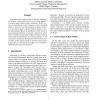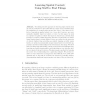26 search results - page 4 / 6 » Identifying topological predicates for vague spatial objects |
DEXAW
1999
IEEE
13 years 9 months ago
1999
IEEE
ing spatio-temporal data as abstract data types into already existing data models is a promising approach to creating spatio-temporal query languages. In this context, an importan...
SIGMOD
1994
ACM
13 years 9 months ago
1994
ACM
Spatial joins are one of the most important operations for combining spatial objects of several relations. In this paper, spatial join processing is studied in detail for extended...
ECCV
2008
Springer
14 years 7 months ago
2008
Springer
The sliding window approach of detecting rigid objects (such as cars) is predicated on the belief that the object can be identified from the appearance in a small region around the...
ADC
2004
Springer
13 years 10 months ago
2004
Springer
Aggregating spatial objects is a necessary step in generating spatial data cubes to support roll-up/drill-down operations. Current approaches face performance bottleneck issues wh...
GISCIENCE
2008
Springer
13 years 6 months ago
2008
Springer
Topological relations are sometimes insufficient for differentiating spatial configurations of two objects with critical difference in their connection styles. In this paper, we pr...


